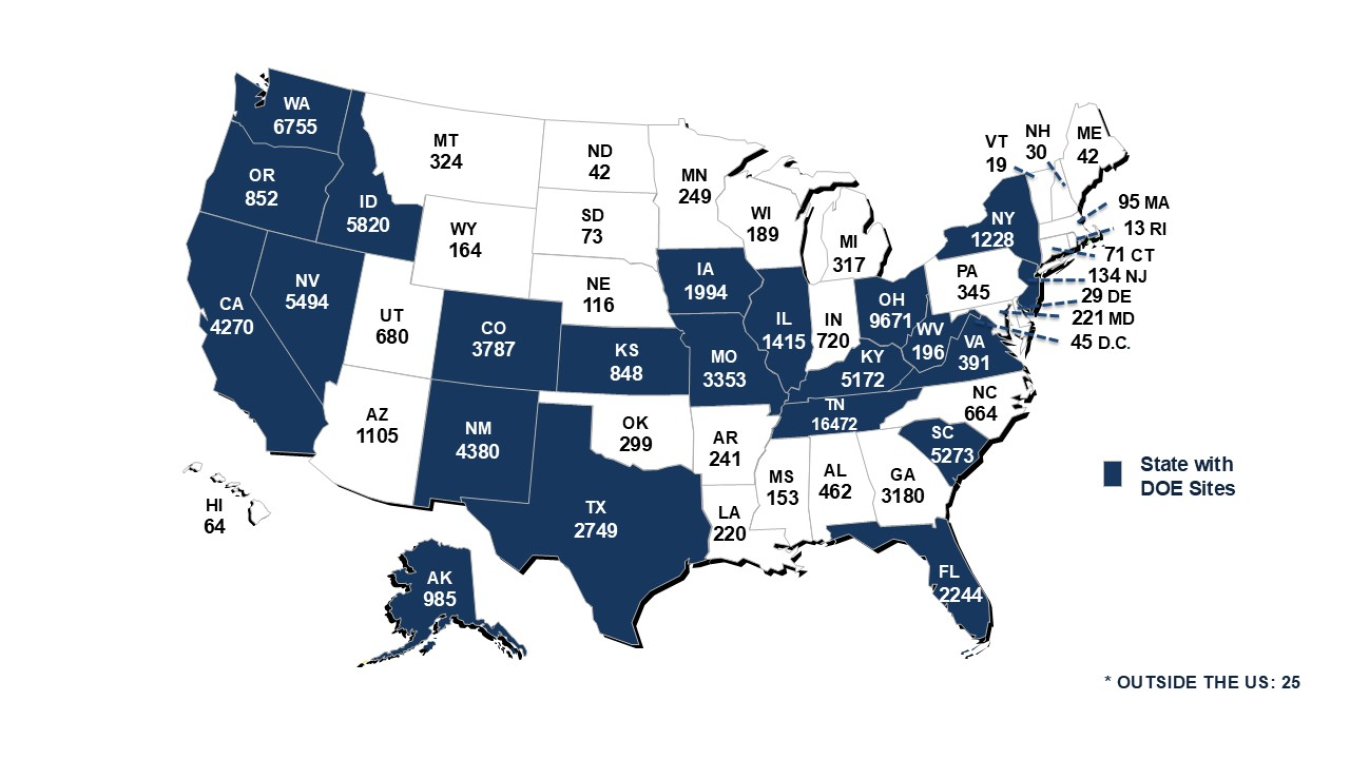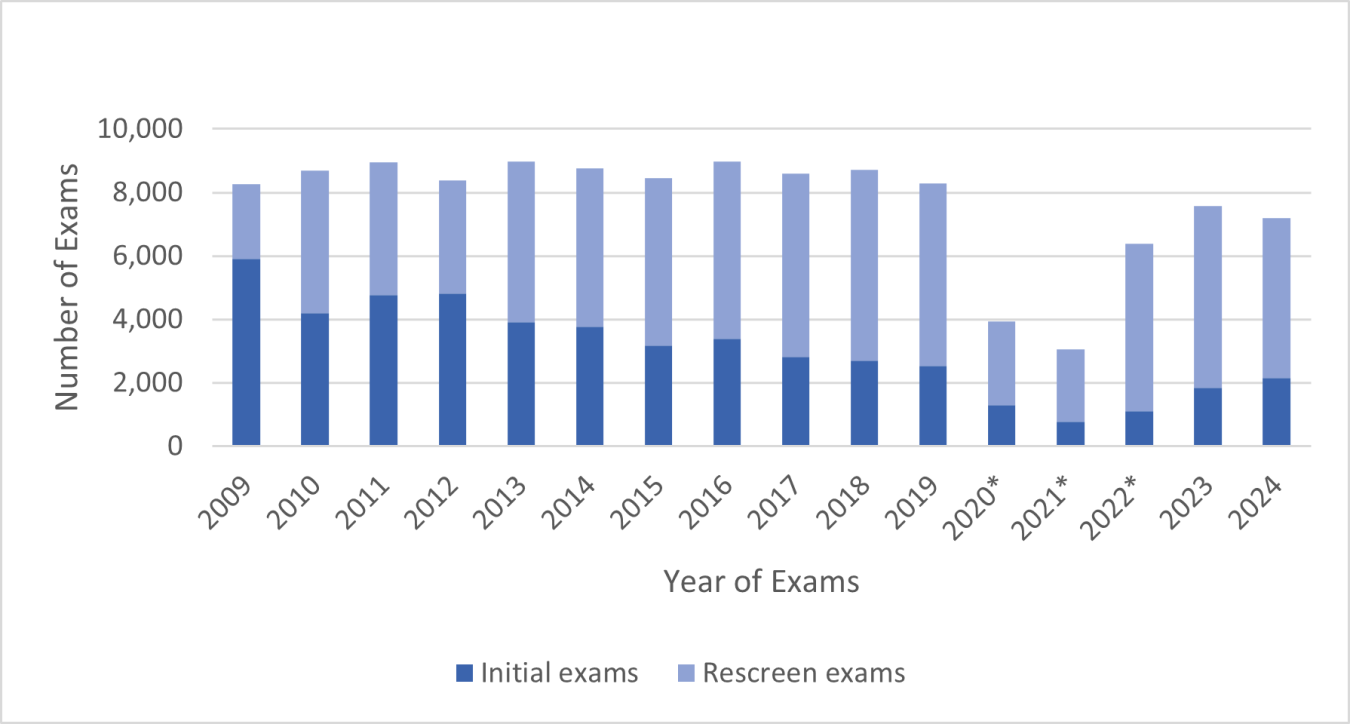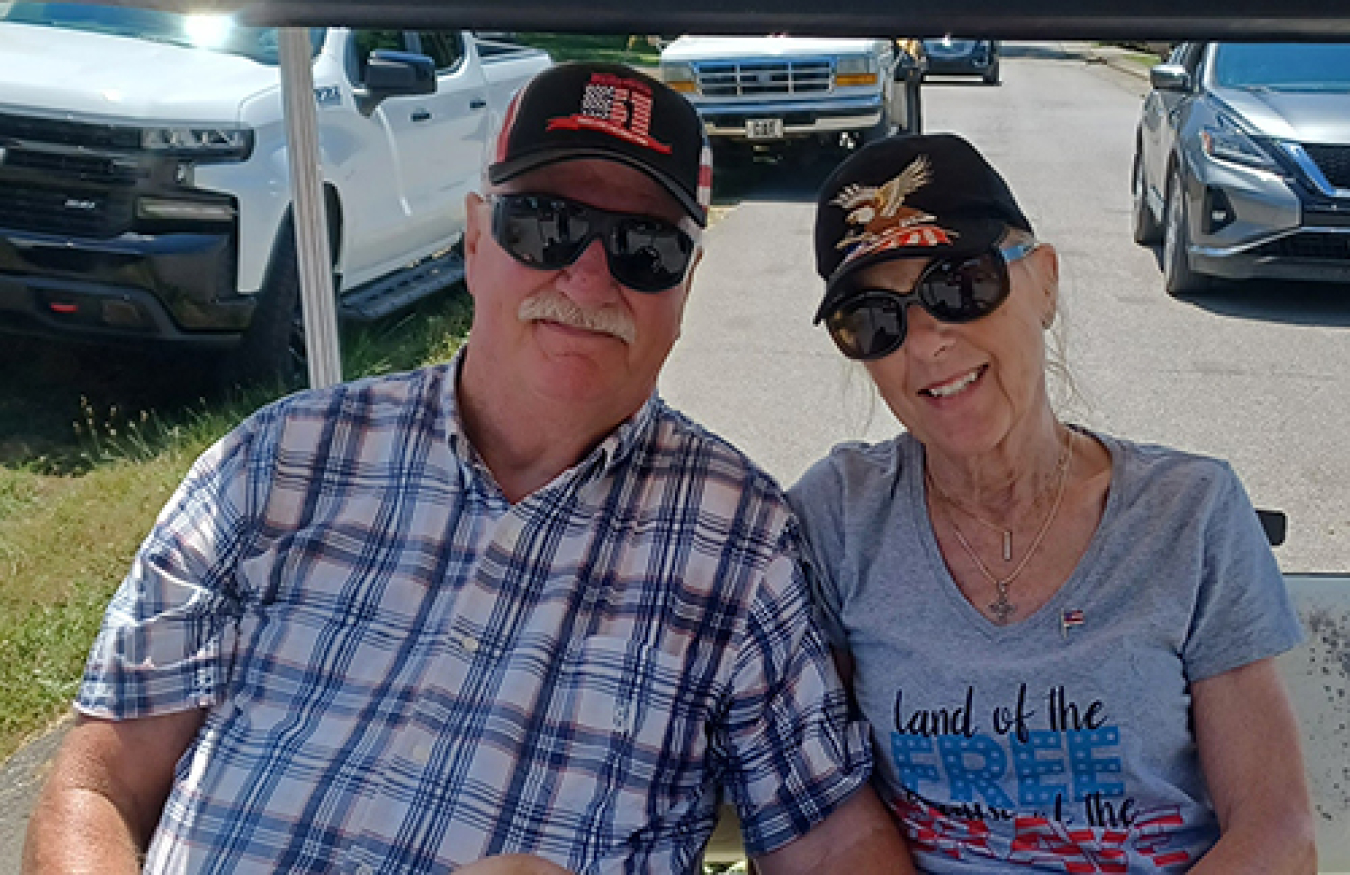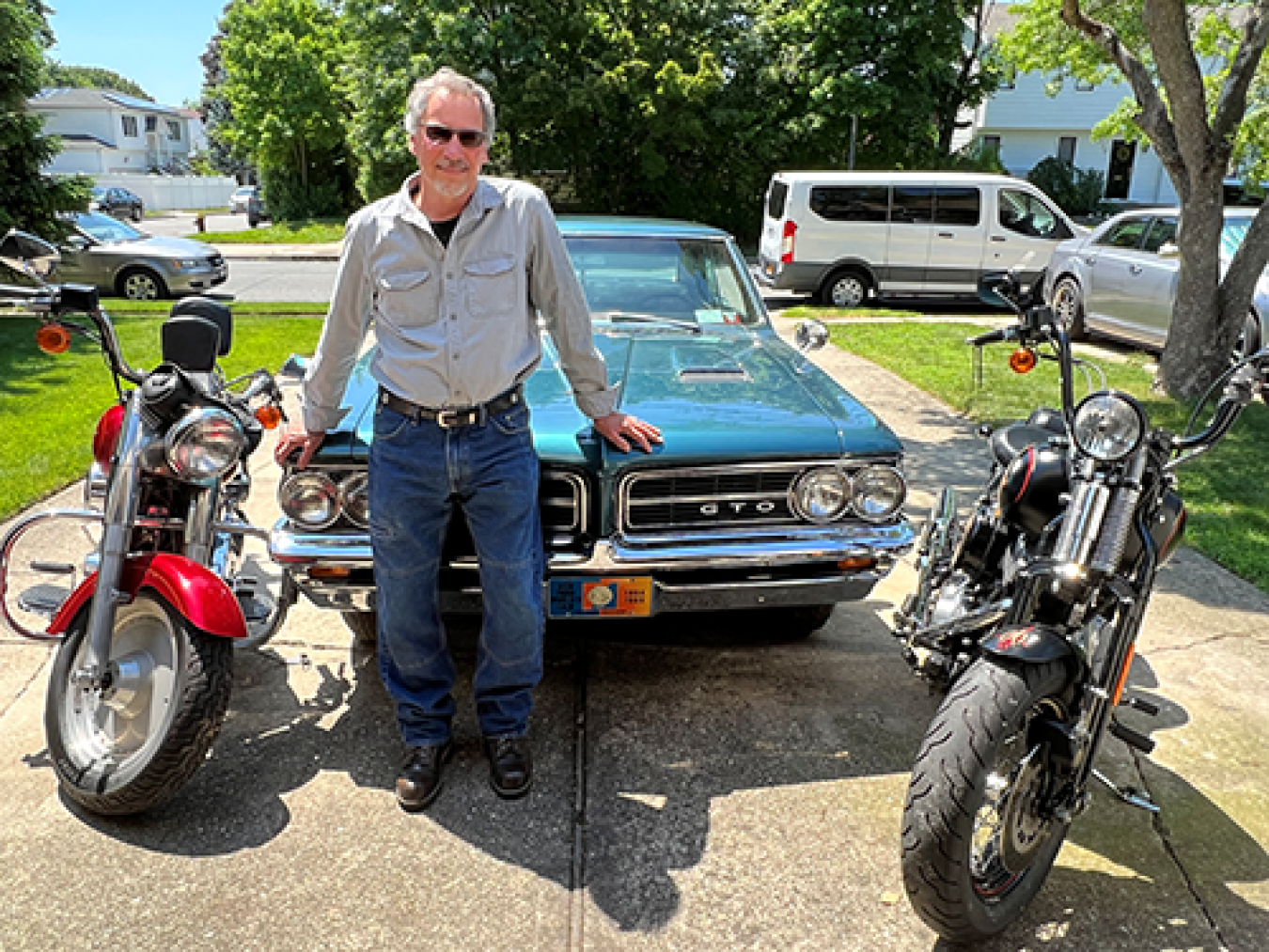The Former Worker Medical Screening Program (FWP) offers ongoing medical screening examinations, at no cost, to all former DOE Federal, contractor, and subcontractor workers who may be at risk for occupational diseases. The FWP is supported by the U.S. Department of Energy's (DOE) Office of Environment, Health, Safety and Security (EHSS) and reflects our commitment to the health and safety of all DOE workers - past and present - who have served the Nation in its National security and other missions.
The FWP uses independent occupational health experts from universities, labor unions, and commercial organizations to administer the medical screening program. To ensure objective and credible medical examinations, the exams are offered by third-party providers. Screenings are provided at clinics in communities near DOE sites, as well as through a large network of health clinics nationwide to allow for services to be provided in close proximity to most workers' residences.
Use the link below to find the closest FWP near your residence.
Former Worker Medical Screening Program Topical Areas
The FWP was mandated by the U.S. Congress as part of Section 3162 of the National Defense Authorization Act for FY 1993 (Public Law 102-484) which called for DOE to:
“… establish and carry out a program for the identification and on-going medical evaluation of its… former employees who are subject to significant health risks as a result of the exposure of such employees to hazardous or radioactive substances during such employment.” The program’s activities began in 1996, and medical screening exams began in 1997.
The FWP offers medical screening exams at no cost to all interested and eligible former DOE Federal, contractor, and subcontractor workers who may have been exposed to toxic substances and hazardous conditions while working at a DOE or a covered DOE-related contractor site. The FWP medical screening exams check for potential adverse health effects caused by exposures to radiation, beryllium, asbestos, silica, welding fumes, lead, cadmium, chromium, solvents, noise, and other toxic substances and hazardous conditions. The program also serves former workers from DOE’s predecessor Agencies, i.e., the Manhattan Engineer District, the Atomic Energy Commission, and the Energy Research and Development Administration.
The FWP is overseen by the DOE Office of Health and Safety within the Office of Environment, Health, Safety and Security (EHSS) and implemented by third-party independent occupational health providers, referred to as FWP Projects, managed by medical experts known as Principal Investigators (PI) and sometimes co-PIs, from universities, labor unions, and commercial organizations. Use of the FWP Projects ensures that the FWP medical evaluation services are objective and credible. The high-quality services, professionalism, and dedication of the FWP Projects to DOE former workers over the past 25 years has resulted in a high level of satisfaction by participants as expressed in outpatient surveys (98.6 percent in FY 2024).
All FWP Projects use multiple outreach methods to notify eligible former DOE workers about the availability of FWP services. The primary method of outreach is direct mailings to former workers inviting them to participate in the program. The FWP Projects also conduct outreach events, e.g., public meetings, health fairs, etc., at DOE sites or in the communities near DOE facilities.
The FWP Projects provide medical screening exams at clinics in communities near DOE sites, and through a nationwide network of health clinics. This network of clinics allows the FWP Projects to provide medical screening exams close to most workers’ residences. Medical screening exams have been conducted in all 50 States and several international locations (see Figure 1). The States which the program screen and where DOE sites are located are shaded blue.
When medical screening exam results identify adverse medical conditions, FWP Projects provide participants information that can be used for follow-up medical care with personal physicians or specialists. When appropriate, the FWP Projects will refer participants to the U.S. Department of Labor (DOL) for potential compensation through the Energy Employees Occupational Illness Compensation Program (EEOICP).
The FWP directly benefits former DOE workers by: (1) identifying signs or symptoms of work-related health conditions at an early more treatable stage; and (2) improving workers’ understanding of health risks they may face due to potential exposures during their employment with DOE.
Figure 1. FWP Participants by State of Residence (1997 – September 2024) *USA state map
 FWP Participants by State of Residence (1997 – September 2024) USA State Map
FWP Participants by State of Residence (1997 – September 2024) USA State MapProgram implementation focuses primarily on four specific activities: outreach, medical screening exams, communications, and protection of participants’ privacy:
1. Outreach: Identify the potential pool of former DOE workers and notify them of FWP services

Since the inception of the FWP, DOE realized there would be challenges in locating workers to participate in the program as there is no centralized database of former DOE workers. When employee rosters, are available from employers or DOE, EHSS works closely with DOE Headquarters program offices to obtain these rosters from site contractors and field/site offices.
Many subcontractors employed workers intermittently, and these companies typically did not leave a copy of employee records with the prime contractor. Thus, the availability of a list of names of former workers (employee roster) varies greatly by site.
The FWP Projects send invitations to individuals using the last known address. When addresses are outdated or inaccurate, the FWP Projects use address-update services to obtain current contact information. The FWP Projects also periodically check the list of workers’ names against the National Death Index to ensure they do not send letters of invitation to decease individuals.
All FWP Projects use multiple outreach methods to notify eligible former DOE workers about the availability of FWP services. The primary method of outreach is direct mailings to former workers inviting them to participate in the program. The FWP Projects also conduct outreach events, e.g., public meetings, health fairs, etc., at DOE sites or in the communities near DOE facilities. In FY 2024, the FWP Projects participated in 387 outreach events and assisted the DOL with 11 of its outreach events. Workers also receive exit packets with program information and the hyperlinks to retiree/DOE site webpages when separating from a DOE or DOE-related site. Despite the outreach efforts, there are many reasons why former workers may not wish to participate in the FWP, including that they believe they are in good health, they are simply not interested in screening, they may harbor a mistrust of a government program.
2. Medical Screening: Provide medical screening exams designed to check for adverse health conditions related to occupational exposures in former workers who choose to participate in the program, including re-screen medical exams every 3 years.

A. Conventional Medical Screening Exam Program
The FWP offers conventional medical screening exams that evaluate a former employee’s health as it relates to the individual’s potential occupational exposure to toxic substances and hazardous conditions. The initial medical screening exam includes a physical examination and may consist of the following based on the individual’s occupational exposure history:
- Chest x-ray with B reading (interpretation for occupational lung disease),
- Spirometry / Pulmonary Function Test (breathing test),
- Beryllium Lymphocyte Proliferation Test (to detect beryllium sensitization),
- Blood chemistry test,
- Urinalysis, and/or
- Audiometry (hearing test)
A team of independent physicians, specializing in occupational medicine, helped develop the FWP medical screening exam program. This protocol is periodically updated as necessary or at least every 2 years based on new research findings within the scientific/medical community. The most current update, in FY 2021, included language regarding COVID-19 related testing to the FWP examination protocol. The health conditions targeted in the medical screening exams include chronic lung diseases, lung cancer, beryllium-related disorders, hearing loss, and damage to other selected major organs that may be associated with occupational exposures. A list of exposures and medical examinations offered through the FWP is available in the medical protocol posted on the FWP Website.
Medical screening exams can identify diseases or precursor conditions at an early stage of development, often before signs and symptoms occur. Clinics can refer individuals with suspicious findings to their personal physician or a specialist for further testing, diagnosis, and treatment. The FWP is not a substitute for routine medical exams received through an individual’s personal physician; however, the program provides some general health screening services that are beneficial to workers.
Before participating in the medical screening exam program, former workers must complete a medical history questionnaire and an occupational history questionnaire, either on their own or via an interviewer-conducted session. In many cases, the interviewers are former workers with knowledge of DOE sites and the type of exposures at the sites.
Participation in the FWP is voluntary, and participants can refuse any portion of the medical screening examination.
Due to the latency period (the time between the onset of exposure and the diagnosis of the disease) of occupational-related diseases, the FWP offers re-screen medical exams every 3 years after the initial medical screening exam. Rescreening medical exams improve the detection of occupational diseases, so it is essential that rescreening resume as soon as it is safe to do so. Certain medical exams may be recommended only during the initial screening exam and excluded from the re-screen exam.
In addition to identifying conditions that may have been related to workplace exposures, the FWP also provides some general health screening services. Screenings include some common non-occupational health conditions, such as diabetes (blood sugar), coronary artery disease (cholesterol), cardiovascular disease/hypertension (blood pressure), obesity, and chronic kidney dysfunction (serum creatinine levels).
The results of general health screening tests, and findings during examinations can be of great benefit to the participants. The participant’s personal physician can treat many of the conditions that fall into this category, significantly improving longevity and quality of life.
A cumulative summary of FWP conventional medical screening exam findings are provided below in Figure 2. This chart contains the number of initial and re-screen exams conducted by DOE site. The asterisk notates the years where the FWP did not conduct as many medical screening exams as in previous years. This is due to the program’s shut down in response to the COVID-19 pandemic.
Figure 2. Conventional Medical Screening Exams Conducted

B. Early Lung Cancer Detection Program (ELCD):

In 2000, the FWP initiated the ELCD program to detect lung cancers at an earlier, more treatable stage using low-dose CT scans. Low-dose CT scans have proven to be better than conventional chest x-ray for the early detection of cancers when treatment is more likely to be effective at preventing death.
DOE made low-dose CT scans available to many former workers who may be at risk for occupational lung cancer because of their work for DOE. Occupational hazards, such as exposure to asbestos, ionizing radiation, silica, beryllium, and diesel exhaust, may cause or contribute to the disease. Low-dose CT scans detect abnormal cells before they can develop into cancer and find cancer at its earliest stages before it has spread.
ELCD participants are offered initial/baseline, follow-up, and annual low-dose CT scans.
If an individual’s initial/baseline scan shows one or more nodules that are not highly suspicious for cancer, they were offered a follow-up scan at 3 or 6 months to determine if there have been any changes. If a nodule is suspicious for lung cancer, the participant is referred to a specialist for diagnostic evaluation.
Ongoing annual low-dose CT scans are offered if an individual’s initial/baseline scan is normal. This is to determine if new nodules are present or if there are changes in previously detected nodules, which may indicate that lung cancer is present. The ELCD program is making every effort to maintain to this timeline of screening, however due to the pandemic, some screening may be delayed.
The FWP Projects currently participating in the ELCD program include WHPP, BTMed, and the University of Iowa. Other FWP Projects are exploring how to incorporate low-dose CT scans into their current protocols.
The FWP Projects continued low-dose CT scans during the pandemic because lung cancer is easiest to treat at its earliest stages. It was even more important to continue the follow-up low-dose CT scans because they are performed in response to the identification of a suspicious nodule or some other medical finding that necessitates a follow-up appointment. In FY 2024, 2,923 FWP participants received at least one low-dose CT scan. Some individuals had multiple low-dose CT scans during FY 2024 because they required a follow-up low-dose CT scan. The FWP performed a total of 3,074 low-dose CT scans in FY 2024, including 186 scans among newly enrolled program participants (baseline scans) and 2,888 annual or follow-up low-dose CT scans. Since 2000, the ELCD program has screened 16,219 eligible participants and provided 73,662 low-dose CT scans. As of the end of FY 2024, this vital component of the FWP has detected 300 lung cancers.
3. Communicate Results: Provide medical screening exam results to participants, as well as information concerning any conditions that may require follow-up medical care with their personal physicians or specialists and offer information regarding possible compensation for work-related illnesses.

Occupational medicine physicians review the results from the FWP medical screening exams, along with the completed medical and occupational exposure history questionnaires, to determine whether any abnormal findings exist and whether the findings may be work-related.
Participants requiring urgent medical attention for an abnormal test result are contacted immediately by phone, informed of the finding, and provided recommendations for further evaluation and treatment by their personal physicians or a specialist. Urgent findings are also documented in a letter to the participant that is sent by overnight mail.
All participants are provided with a summary of findings, both occupational and non-occupational related, in a results letter several weeks after their examination, along with any necessary follow-up recommendations. The results letter also includes general health advice for workers, such as recommendations to quit smoking. While the FWP Projects offer medical screening exams, follow-up medical evaluation and treatment are not within the scope of the FWP.
When appropriate, the FWP Program physicians who review the medical screening exam results, include language in the results letters regarding the possibility that an identified condition may be work-related especially if the condition is known to be a potential occupational disease. The inclusion of this language, known as “causation” language, can be helpful for participants considering whether to file a claim under the EEOICPA administered by DOL. In addition, the FWP Programs provide participants with contact information in the results letters for DOL EEOICPA Resource Centers, as well as other State and Federal workers’ compensation programs when appropriate.
While participation in the DOE FWP is not required for filing an EEOICPA compensation claim, the medical results may be useful in supporting a claim by offering former DOE workers with detailed information about the possible relationship between their condition and their occupational exposure at a DOE or DOE-related site. FWP project staff, many of whom are former DOE workers, can also assist participants by providing useful site and exposure information to include in their claim packages
4. Protect Personally Identifiable Information and Protected Health Information: Protect the confidentiality and privacy of participants.
The confidentiality and privacy rights of former workers are not only a legal requirement, they are also crucial to establishing and maintaining credibility with the DOE former worker community. All medical information collected as part of the FWP is confidential and used only as allowed by the Privacy Act of 1974 and the Health Insurance Portability and Accountability Act (HIPAA). The FWP conducts all activities with the approval of the Institutional Review Boards, or Human Subjects Committees, of DOE and involved organizations. All individuals sign an informed consent and HIPAA authorization before participating. In addition, all program staff take annual privacy awareness training, and all FWP Projects have security procedures in place for the safe transmittal and storage of protected information.
The FWP infrastructure consists of four designated regional projects located near major DOE sites, as well as two nationwide projects. Click on the links below to find program descriptions and program staff biographies.
The regional projects include:
- Pantex Former Worker Program, conducted by The University of Texas Health Sciences Center at Tyler
- Worker Health Protection Program conducted jointly by Queens College of the City University of New York, United Steelworkers, the Atomic Trades and Labor Council in Oak Ridge, the Johns Hopkins University School of Public Health and the former Fernald Atomic Trades and Labor Council
- Former Worker Medical Screening Program for Line 1/Division B Iowa Army Ammunition Plant and Ames Laboratory conducted by The University of Iowa College of Public Health
The two nationwide projects include:
- The National Supplemental Screening Program, conducted by Oak Ridge Associated Universities in conjunction with National Jewish Health, Comprehensive Health Services, Axion Health, and the University of Colorado Denver
- The Building Trades National Medical Screening Program, conducted by CPWR - The Center for Construction Research and Training in conjunction with the University of Cincinnati Medical Center, Duke University Medical Center, and Zenith American Solutions, Inc.
I like getting screened every 3 years. Gets things checked that the normal doctor does not do unless something happens.
Burlington AEC Plant former workerI think this program is a wonderful benefit for former workers and the research being done is great. I will highly recommend and encourage other former workers. I think all should participate.
Ames Laboratory former workerThis CT Scan saved my life because it showed a tumor on my kidney that I didn't know was there. Now it's gone, and I am cancer free!
Ron VanderMeeden, Former Savannah River Site Worker, Plumbers & Pipefitters Local #447 Ron VanderMeeden
Ron VanderMeedenThe doctor I saw was terrific. If I ever need to change my primary doctor, she will certainly be considered.
Steve Danay, Former Brookhaven National Lab Worker, Ironworkers Local #361 Steve Danay
Steve DanayAfter following up on my abnormal NSSP chest x-ray, I was diagnosed with lung cancer. At that time, I had no symptoms that would have led me to see a doctor. I am confident that the NSSP recommendations are the reason I got an early diagnosis.
Hanford Former WorkerThe way you guys set this up is great and I wanted to thank you for making it so easy. The doctor at the clinic was kind and very personable and the staff was wonderful. No wait time. The clinic was clean.
Ames Laboratory Former WorkerAllow me to express gratitude for your program. My blood work and x-ray were identified as abnormal on my screening test. I am happy to report that the x-ray abnormality was quickly resolved with a negative CT scan. The blood work eventually led to a diagnosis of lymphocytic leukemia, but I am grateful for the early detection.
Portsmouth ParticipantI would like to thank the Worker Health Protection Program for all of the resources and tools they provide to help workers of the DOE plants.
Fernald participantThe annual Medical Screening Findings are available for users to select and view findings for specific medical screenings results. Users may print a PDF version or export a Microsoft Excel version of the selected information. Please select the link below to view these results:
Learn more about the Annual Medical Screening Findings.
- A Basic Overview of the FWP (Brochure)
- Covered Sites/Populations
- FWP Fact Sheet
- FWP Medical Protocol
- FWP Summary of Services
- Medical Facilities with Experience Evaluating Chronic Beryllium Disease
- National Institute for Occupational Safety and Health Dose Reconstruction
- Publications
- Surveillance Case Definitions
- U.S. Department of Labor (DOL) Division of EEOICPA
- U.S. Department of Labor (DOL) Office of the Ombudsman for the EEOICPA
- Webinars

